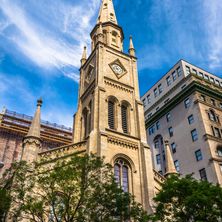

Considered one of the oldest continuous Protestant parishes in America, the ornate Marble Collegiate Church was built between 1851 and 1854 by architect Samuel A. Warner in Romanesque Revival style. The façade and the 65-meter-high steeple were built from Tuckahoe marble, a type of mineral found in upstate New York. The steeple is topped with a weathercock, alluding to the rooster that crowed three times after Peter the Apostle denied Christ. Inside, the only decorative element is the two stained-glass windows on the south wall. There are no icons, crucifixes or images of Christ, a tradition that, according to John Calvin, helps the worshiper concentrate on Christ's message, rather than His persona.
The congregation is part of the Reformed Church in America. It was founded in 1628 as the Collegiate Reformed Protestant Dutch Church, a Calvinist church based in the Netherlands. The original Marble Collegiate Church stood near present-day Wall Street. Collegiate means that worship services are performed by a college of canons, that is, non-monastic clergy, who are rotated among the pool of churches. Although this system of rotating clergy was abandoned in 1871, the church maintained the name Collegiate, and there are four such churches in New York today, which administrate common properties and investments.
The most fascinating fact about the Collegiate Church is that it is the oldest corporation in America. When the British conquered New York from the Dutch, King William III granted the church a Royal Charter. This was in 1696. Therefore, formally and juridically, the Collegiate Church is the oldest non-governmental institution in America.